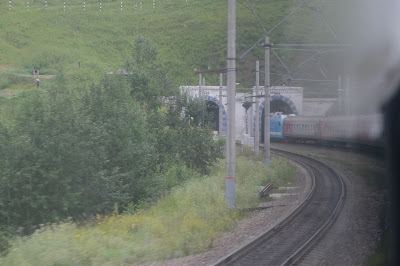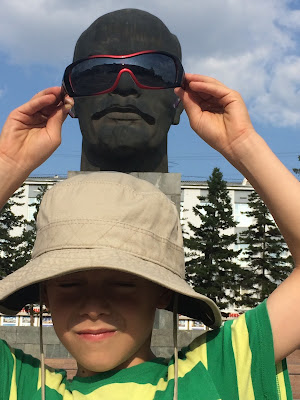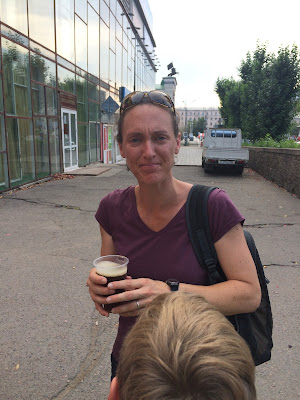And we ate 9...NINE.....of these delicious things. I forget the name in Russian (and couldn't write it even if I knew), but they were filled with potato, meat, or cabbage. We got 3 to try, then spent the next hour intently watching the train corridor to see if the lady would pass back by so we could get more. She did....and we got another 4. Then, about an hour later, she stopped specifically back by our compartment with her final 3......which we promptly bought and ate, too. They were delicious (my favorite was the cabbage ones)!
The route between Irkutsk and Ulan-Ude is particularly scenic because, for quite a while, the train tracks are right along the coast of Lake Baikal. It was a rainy day but the views we did have were still pretty.
As we got closer to Ulan-Ude, there was also a river that was quite scenic.
We stayed quite a while in Ulan-Ude--6 nights. Ulan-Ude is not a particularly large city, and so this turned out to be longer than we ultimately needed (this is the disadvantage to booking transport in advance). However, the longer stop gave us time to move a little slower and relax a bit more.
Ulan-Ude is the capital of the Buryat Republic (it's also called Buryatia). There are about 500,000 Buryat people, and they make up the largest indigenous group in Siberia. Most Buryats live in or around Ulan-Ude, and as a group they share many customs with Mongolian people. There is a separate Buryat language, and the Buryats look quite different in appearance from Russians in the western part of the country. On the map below, you can see the Buryat Republic in red.
One of the things that Ulan-Ude is most known for is a giant bust of Lenin that graces the central square. The monument, weighing 42 tons and with a height of 7.7 meters (25 feet), is the largest bust of Lenin in the world (where are all the others?). It was installed in 1970 to commemorate Lenin's 100th birthday; interestingly, the sculptor gave Lenin particularly Buryat-ish facial features.
Nowadays, Lenin's giant bust entertains tourists, who like to take funny pictures with the sculpture. Here are some of ours!
Emmett with a giant Lenin head....
Colin giving Lenin a noogie...
Lenin posing with 3 of 4 Moorhouses...
Giving Lenin a kiss...
Lenin wearing Colin's new sunglasses...
And Bob squishing Lenin's head.
One of our favorite sights was the Ethnographic Museum. Located in a large wooded area outside the city center, the museum features buildings collected over time from all over Siberia. These original structures were moved to the Ethnographic Museum, and visitors can stroll through 7 different areas that feature buildings from different locations and groups.
The construction and detail of the wood was really interesting.
We saw our first gers up close---a taste of what is to come in Mongolia! This one was interesting and different because of the earthen roof.
As we were leaving this section, a lady urgently called out and motioned to us (all in Russian). Turns out we had almost missed an important site! There was a large wooden carving that brought protection from evil spirits to those who walked through it. We definitely made a point to all pass through...we'll take all the protection we can get.
After we finished with Chichipkan, we were about to leave the section when the lady called out to us again and then walked us over to this tree. As she gave a lengthy explanation (again, all in Russian), she kept motioning for us to pose like the tree. We still have no idea why this was important, but it clearly was to her...so we all obliged.
There was also an exhibit of beautiful crafts, costumes, and artwork.
When we got back into Ulan-Ude, I wanted to try kvass. Our hostel guide told us that when it's hot in Siberia, everyone drinks this concoction that "tastes like bread". Since it was in the mid- to high- 90's F (30's C) for almost our entire stay in Ulan-Ude, we saw people drinking it everywhere.
This is me excited to try something local...
This is the shot Bob got of me after I actually tasted kvass...
We gave Lenin the rest of our glass.
Another important and interesting site is Ivolginsky Datsan, the center of Buddhism in Russia. The Buryats have traditionally practiced Buddhism; after WWII, the local people wrote to Stalin (who was especially anti-religious) and asked if they could build a monastery. Somewhat surprisingly, he gave permission for the construction of the monastery. Today, the complex contains temples and a Buddhist university.
Tatiana taught us how to enter and exit a temple (always enter in the left door and exit from the right), how to walk in a Buddhist temple (never turn your back on the altar, so after approaching it you back out of the temple with small steps), how to make an offering of coins or white foods while the monk is blessing you (put them in your outstretched hands and make small clockwise circles). It was great to learn more about the customs and rituals since I'm sure we'll be visiting quite a few temples in the future.
We also went into one temple where the monk said a prayer to bring prosperity to each of us and all of our relatives (you're welcome, everyone).
One of the unique features of Ivolginsky Datsan is the Imperishable. As Wikipedia explains,
In 1927, the 12th Pandito Hambo Lama of the Ivolginsky Datsan, Dashi-Dorzho Itigelov, told his students and fellow monks to bury his body after his death and to check on it again in 30 years. According to the story, Itigelov then sat in the lotus position, began chanting the prayer of death, and died, mid-meditation. The monks followed Itigilov's directions, but when they exhumed his body 30 years later, they were amazed to find none of the usual signs of decay and decomposition. On the contrary, Itigilov looked as if he had been dead only a few hours, rather than three decades. Fearful of the Soviet response to their "miracle", the monks reburied Itigilov's body in an unmarked grave.
Itigelov's story was not forgotten over the years and on September 11, 2002 the body was finally exhumed and transferred to Ivolginsky Datsan where it was closely examined by monks and by scientists and pathologists. The official statement was issued about the body – very well preserved, without any signs of decay, whole muscles and inner tissue, soft joints and skin. The interesting thing is that the body was never embalmed or mummified.
We visited the temple that houses the Imperishable with an offering of blue scarves. The monk inside the temple then knotted the scarves, which were now considered to be blessed by the Imperishable. Here's Emmett with his scarf (outside a different temple).
On our last day in Ulan-Ude, we decided to head to the western shore of Lake Baikal. Since we'd seen pretty much everything the city had to offer, we thought it would be nice to spend our last day at one of the places we liked the most in all of Russia.
Driving in Ulan-Ude was an adventure....it is definitely not an orderly and delineated traffic experience! This is a tram making its way through oncoming traffic.
And this was one of the many cows we passed on the road.
But the crazy driving was worth it because the lake was fantastic! We enjoyed one final Russian beach day by resting, eating junk food, and playing in the C-O-L-D water. I'm pretty sure you can hear me screaming in this last photo.
Here's a short video of Lake Baikal from the western shore. It is so hard to believe this massive body of water is a freshwater lake!
When we got back to Ulan-Ude, we got some dinner with Sascha, one of the hostel guides. He was a friendly guy, and he enjoyed talking and playing with the boys during our stay. After a quick bite to eat, we stopped to enjoy the beautiful fountains just off the central square. Sascha pointed out different buildings and we got to know him a bit more--it was a really nice evening together.
And, of course, we took one more Lenin head photo. Because that's what you do in Ulan-Ude!















































No comments:
Post a Comment